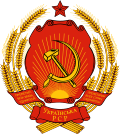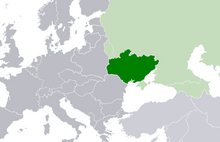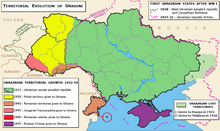Ukrainian Soviet Socialist Republic
| Українська Радянська Соціалістична Республіка Украинская Советская Социалистическая Республика |
|||||
| Ukrainian Soviet Socialist Republic | |||||
|
|||||
| Official language | officially none; de facto preferring Russian to Ukrainian 1 | ||||
| Capital |
Kharkov (1919–1934) Kiev (1934–1991) |
||||
| surface | 603,700 km² | ||||
| population | 51,706,746 | ||||
| Population density | 85.6 inhabitants per km² | ||||
| National anthem |
Anthem of the Ukrainian Soviet Socialist Republic |
||||
| Time zone | UTC + 2 | ||||
| (1) With the constitution of the USSR of April 20, 1978, the Ukrainian language (de jure) became the official language of the USSR. Russian was given the status of a lingua franca . | |||||
The Ukrainian Soviet Socialist Republic (abbreviation USSR or UkrSSR , Ukrainian Українська Радянська Соціалістична Республіка, УРСР ; Russian Украинская Советская Социалистическая Республика, УССР ; until 1936/37 Українська Соціалістична Радянська Республіка, УСРР) was born on 24 December 1918 jul. / January 6, 1919 greg. and was one of its Union Republics from the establishment of the Union of Soviet Socialist Republics (USSR) in 1922 until its collapse at the end of 1991 .
The capital was Kharkov from 1919 to 1934 , then Kiev .
history
prehistory
Ukrainian People's Republic
In March 1917, the Zentralna Rada ( Central Soviet , Central Council ) was formed as a decision-making body in the Ukrainian part of the Russian Empire . From April she took on legislative and administrative functions.
On November 7 (20) it proclaimed the autonomous Ukrainian People's Republic in the federal new Soviet Russia. In the subsequent elections, the Bolsheviks received 25% and the other parties 75% of the vote. On January 18, 1918, the Central Rada declared the state independence of the Ukrainian People's Republic.
Ukrainian Soviet Republic
In December 1917, under the leadership of the Bolsheviks, a Central Executive Committee of Soviet Ukraine was founded in Kharkiv , which sought to establish closer ties between Ukraine and Soviet Russia . On December 17 (30), this proclaimed the Ukrainian People's Republic of the Soviets (also Ukrainian Soviet People's Republic or Soviet Ukrainian People's Republic ) as an autonomous republic within Soviet Russia. It comprised small parts of eastern Ukraine around Kharkiv. In March, the Ukrainian Soviet Republic declared itself an independent state. In April it disbanded after the invasion of German and Austrian troops .
Other Soviet republics
In the spring of 1918 there was also the Soviet Republic of Donetsk-Krivoy Rog , the Soviet Republic of Odessa and the Soviet Socialist Republic of Taurida (in Crimea).
Ukrainian state
On April 29, 1918, after a coup, the Ukrainian State ( Hetmanat Ukraine ) was formed in Kiev with the support of the German and Austrian occupying powers. It ended on December 14, 1918.
Establishment of the Ukrainian Soviet Socialist Republic
After the conquest of Kiev by the Bolsheviks, the Ukrainian Soviet Socialist Republic was proclaimed by them in January 1919 . In March, the first constitution was adopted by the All-Ukrainian Central Executive Committee .
On December 30, 1922, it became part of the Soviet Union , while the territory of the West Ukrainian People's Republic, which existed from 1918 to 1919, had already come to Poland , Romania and Czechoslovakia with the Treaty of Riga in 1921 .
Stalinism and Holodomor
Since the 1930s, Ukraine, like all parts of the USSR, has been exposed to Stalinist terror. In the great famine of 1932/1933, the Holodomor , around 3.5 million people were killed in Ukraine.
Expansion through the Polish western Ukraine

In 1939, in accordance with the secret additional protocol to the German-Soviet non-aggression pact , the Polish western Ukraine was annexed by the USSR and added to the Ukrainian SSR (see Soviet occupation of eastern Poland ). The new territory was divided into the oblasts of Lviv , Drohobych (incorporated in Lviv Oblast in 1959), Ternopil and Stanislaviv (now Ivano-Frankivsk Oblast ).
German occupation
During the German occupation (1941–1943 / 44), the country was exposed to a brutal Nazi policy of repression as Reichskommissariat Ukraine , but the area of this Reichskommissariat was not completely identical to the SSR.
1944 to 1988
The Ukrainian SSR (like the Belarusian SSR ) was admitted as a founding member of the UN , alongside the Soviet Union , and had its own vote in the General Assembly, which was always cast in bloc with the USSR. In 1940/1947 northern Bukovina (as Chernivtsi Oblast ) and in 1945 Carpathian Ukraine (as Transcarpathian Oblast ) were attached to the Ukrainian SSR. The Autonomous Soviet Socialist Republic of Crimea was initially part of the Russian SFSR and was only added to the Ukrainian SSR in 1954 .
Aspirations for independence
On September 10, 1989, the Ukrainian people's movement Narodnyj Ruch Ukrajiny was founded in Kiev . The delegates called for the national and economic sovereignty of Ukraine within a Soviet confederation, as well as an improved status of the Ukrainian language and more rights for the Christian churches alongside the Russian Orthodox Church.
In the elections to the Supreme Soviet of March 4, 1990 in the Ukrainian SSR, the Communist Party of Ukraine achieved a little over 70% of the parliamentary seats. Volodymyr Iwaschko was initially elected chairman of the parliament, but had to resign when he was on the XXVIII in July 1990. Congress of the Communist Party of the Soviet Union in the newly created office of the party's Deputy Secretary General was elected. His successor was Stanislaw Hurenko , who, as leader of the Communist Party, spoke out on the one hand for the "national sovereignty" of Ukraine and for a "spiritual rebirth" of the country, on the other hand he wanted to prevent the country from leaving the Soviet Union.
On July 16, 1990, the Supreme Soviet in Kiev issued a declaration of sovereignty by 355 votes against 4, placing the laws of the Ukrainian Soviet Republic over those of the Soviet Union.
On January 1, 1991 there were 51.9 million residents.
State independence
Through the August putsch in Moscow in 1991 , the Supreme Soviet in Kiev decided on August 24, 1991 with 346 of 450 votes to leave the Soviet Union and create an independent state. With a referendum on the independence of Ukraine on December 1, 1991, the country broke away from the Soviet Union.
population
In 1984 there were 50.8 million inhabitants in the Ukrainian SSR, 74% of them Ukrainians, 21% Russians and 5% other ethnic groups. In 1979 the proportion of Ukrainians in the entire Soviet Union was around 16.1%.
Party leaders
The First Secretaries of the Communist Party of the Ukrainian SSR
|
|
|
|
Heads of state
The chairmen of the Supreme Soviet of the Ukrainian SSR
|
|
|
Heads of government
Chairman of the Council of Ministers of the Ukrainian SSR
|
|
|
|
literature
- Kerstin S. Jobst: History of Ukraine . Reclam, Stuttgart 2010, ISBN 978-3-15-018729-6 (= Reclams Universal Library 18729).
Web links
- Governments of the Ukrainian Soviet Socialist Republic (English)
- Constitution of the Ukrainian SSR (Ukrainian)
- Constitution of the Ukrainian SSR (Ukrainian and German)
Individual evidence
- ↑ Constitution of the Ukrainian Soviet Socialist Republic of 1978 Article 73 paragraph 2 and 3.
- ↑ Ukraine commemorates the victims of the famine in the 1930s Report from RIA Novosti , (accessed November 27, 2010).
- ↑ Donald Bloxham, A. Dirk Moses (Ed.): The Oxford Handbook of Genocide Studies. Oxford University Press, Oxford 2010, ISBN 978-0-19-923211-6 , p. 396.
- ↑ Der Spiegel, edition 29/1990
- ↑ And now the Ukraine is awakening , Die Zeit edition 36/1990.




